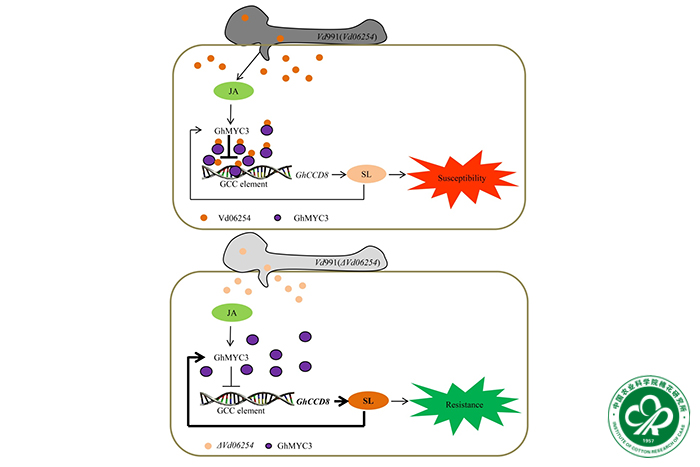- Location : Home» Newsroom
Verticillium dahliae effector Vd06254 disrupts cotton defense response by interfering with GhMYC3-GhCCD8-mediated hormonal crosstalk between jasmonic acid and strigolactones
Verticillium dahliae is among the most destructive plant pathogens, posing a significant threat to global cotton production. Cotton plants have developed sophisticated immune networks to inhibit V. dahliae colonization. Ingeniously, V. dahliae employs numerous virulent effectors to surmount plant immune responses. However, the pathogenic mechanisms of V. dahliae-derived effectors remain elusive. In this study, we demonstrate that the Vd06254 effector from V. dahliae disrupts the synergistic interaction between jasmonic acid (JA) and strigolactones (SL), thereby suppressing cotton immunity. Ectopic expression of Vd06254 enhanced susceptibility to both viral and V. dahliae infections in Nicotiana benthamiana and cotton, respectively. Vd06254 directly interacts with the JA pathway regulator GhMYC3. The nuclear localization signal (NLS) was found to be essential for the virulence of Vd06254 and its interaction with GhMYC3. Additionally, overexpression and knockout of GhMYC3 in cotton modified the plant's resistance to V. dahliae. Our findings further reveal that GhMYC3 inhibits the expression of GhCCD8 by binding to its promoter, potentially regulating SL homeostasis in cotton through a negative feedback loop. This repression was enhanced by Vd06254, highlighting its crucial role in modulating cotton immunity and illustrating how V. dahliae effectors reprogram cotton transcription to disrupt this regulatory mechanism.